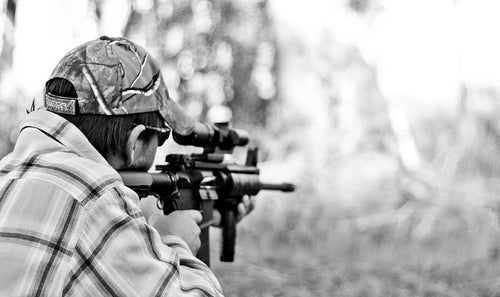SHTF Rifle Considerations: To Operator or Not to Operator?
Jon Stokes 07.19.18

Preppers disagree on so many things, especially where guns are concerned, but most will readily acknowledge the critical role a good centerfire rifle plays in even the most basic preparedness strategy.
As I’ve grown in the gun scence — written, studied, matured, and most of all, trained — my views on what this rifle should be and how it should be configured have evolved quite a bit. And oddly enough, they’ve sort of gone in a circle. I started out with Jeff Cooper’s scout rifle concept, then ditched it as old fogey in favor of the “use what they use” motto of operator wannabees everywhere, and I’ve now come back around to seeing the wisdom of Cooper’s thinking.
I still believe an AK- or AR-15-pattern rifle is the best choice for those who live in an area where that’s an option, but I think Cooper’s recommendation of a simple, handy, lightweight bolt action gun isn’t as far off as most members of the 101st Chairborne Rangers would have you believe.
To set up some context for this discussion, I want to talk about the “operator gun” and about the considerations that go into it.
Operator guns & the operators who operate them
This video and accompanying article from former SF guy Frank Proctor is a great, quick introduction to how one operator has approached the problem of configuring an AR-15 over the course of his career.
https://www.youtube.com/watch?time_continue=775&v=0NPbpNX406U
I want to bring out two very important points from this video that are relevant for our discussion, here.
The first point is that Proctor mentions that his rifle is specifically set up to allow him to function as part of a squad. He is trained in squad tactics, and whenever he’s using this gun in the field he’s in a unit where somebody else is carrying a larger, longer-range weapon that can engage targets at distance.
This point also comes up in the opening chapters of the classic Black Rifle book, which discuss the change in military doctrine that gave rise to the selection of the 5.56 NATO round for US troops in the Asian conflicts. Instead of handing every soldier a heavy .30-cal rifle capable of shooting out to intermediate and even long range, the military realized it was better to hand most guys in a unit a carbine for engagements at 300 yards and under, and let a few of them man longer-range guns.
In this context, Proctor’s choice of a 14.5″ barreled rifle with a suppressor makes perfect sense, because if the target is too far out there he can count on his unit’s sniper or vehicle-mounted weapon to engage, instead.
The second thing I want to point out is that Proctor and the other SF guys have the best logistical support money can buy. They’re shooting a very tightly controlled selection of ammo, and their gun only has to be reliable with the ammo they carry, not with whatever they might scrounge in the field. It’s also the case that on the missions on which they’re carrying these short, tricked-out carbines they’re not in the field with no access to an armory for months at a time. Quite often they’re only out for no more than a few days, and very often just a few hours.
You are not an operator, nor will you be one in TSHTF
Neither of the two points above probably applies to you in a SHTF scenario; you’re unlikely to be part of a trained squad with defined roles, and you may not have access to fresh gear, parts, and maintenance for months at a time.
For me, in terms of my personal preparedness, these facts have given me a new perspective on my SHTF rifle. Even just a year ago, I was happy to go full “operator” with a “Bin Laden gun” knockoff that includes internal upgrades like a JP Silent Captured Spring and a Geissele trigger. But nowadays I keep it a lot simpler and more flexible.
What this means first and foremost is that my SBR has moved into a backup role, and I’m now using a full-length carbine that I can depend on out to 600 yards (for me that’s intermediate range).
I’ve also changed calibers from 223 to 308 Win, for similar reasons of range and flexibility.
Finally, I’m running a bone stock, high-end AR with a 20″ barrel and no upgrades. Specifically, I run an LMT LM8MWS, but have backed out the trigger and JPSCS upgrades. My reason for this is that I paid a premium in price and weight for a gun whose main selling point is absolute, unfailing reliability with a wide range of ammo types and in all circumstances, so monkeying with critical parts of that is stupid. The gun has been designed and field tested in a specific config, so for SHTF purposes it’s better to run it in that config than to get fancy.
Sure, I’m aware of reports that our SF guys run Geissele triggers and JPSCSes in their guns, and if I could count on the logistic support and ammo uniformity they enjoy, I might consider leaving those upgrades in. But I can’t, so out they go.
A stock config LMT LM8MWS is definitely not what Cooper would recognize as a scout rifle, especially given the weight of the rig and my choice of optic (currently a Leupold Mark 8 CQBSS with Horus reticle). But it’s a lot closer to Cooper’s ideal than the tricked-out AR-15 I was running before, and for some reasons cooper would recognize.
Ultimately, I want to be prepared for a wide range of scenarios, from temporary lack of access to services all the way up to a long-term grid-down scenario, and that means not boxing myself by selecting a specialty gun which presumes a level of support I am unlikely to have.